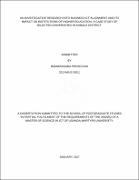| dc.description.abstract | The study was conducted to explore into Business-ICT alignment and its impact on institutions of higher education and then give the different recommendations on how business-ICT alignment can be integrated in institutions of higher education in Kabale district in order to stimulate business growth and development using both qualitative and quantitative techniques. The study was conducted among Assistant Lecturers, (35.5%), Lecturers (20.5%), Head of department, (5.5%), Non-teaching staff (25.5%), and administrators (13.0%). In the study, data was collected through structured interviews and questionnaire from 200respondents. More information was gathered through the use of available literature and observation.
The study found out that the main ICTs used in institution were: computers, application software, tablets, projectors, interactive whiteboard and display monitors. However the general business-I’CT alignment levels in the institutions are till at a minimal level (38%). The study shows that many respondents strongly agreed (51%) and (37%) agreed that Business-ICT alignment is a suitable process for institution progress and success. The study also found out that by improving the integration & alignment of ICT to institutions, the universities will improve their ability to realise institutional vision & goals (76%), provide more agility in response to institutional diversification, growth and development (87%), improve student, staff and partner experiences with greater enterprise capability, (98%), enable greater sharing of knowledge and resources across the enterprise (67%), improve communications (78%). On establishing how business growth and development can be stimulated through business-ICT alignment respondents said it creates direct job, Contributes to GDP growth, Emergence of new services and industries, Workforce transformation and leads to Business innovation
In conclusion, the use of information and communication technologies no doubt is gaining momentum in Ugandan universities. The ICT is used by faculty, staff and students in sourcing information to align business. ICT use in management is highly embraced and this improves management practices. The use of ICT in works of universities management is observed that indeed, it simplifies work and makes it easier for universities’ staff to enjoy their work and hence generate quality decisions for the running of their universities. ICT usage will facilitate development since there will be free flow of information. | en_US |


